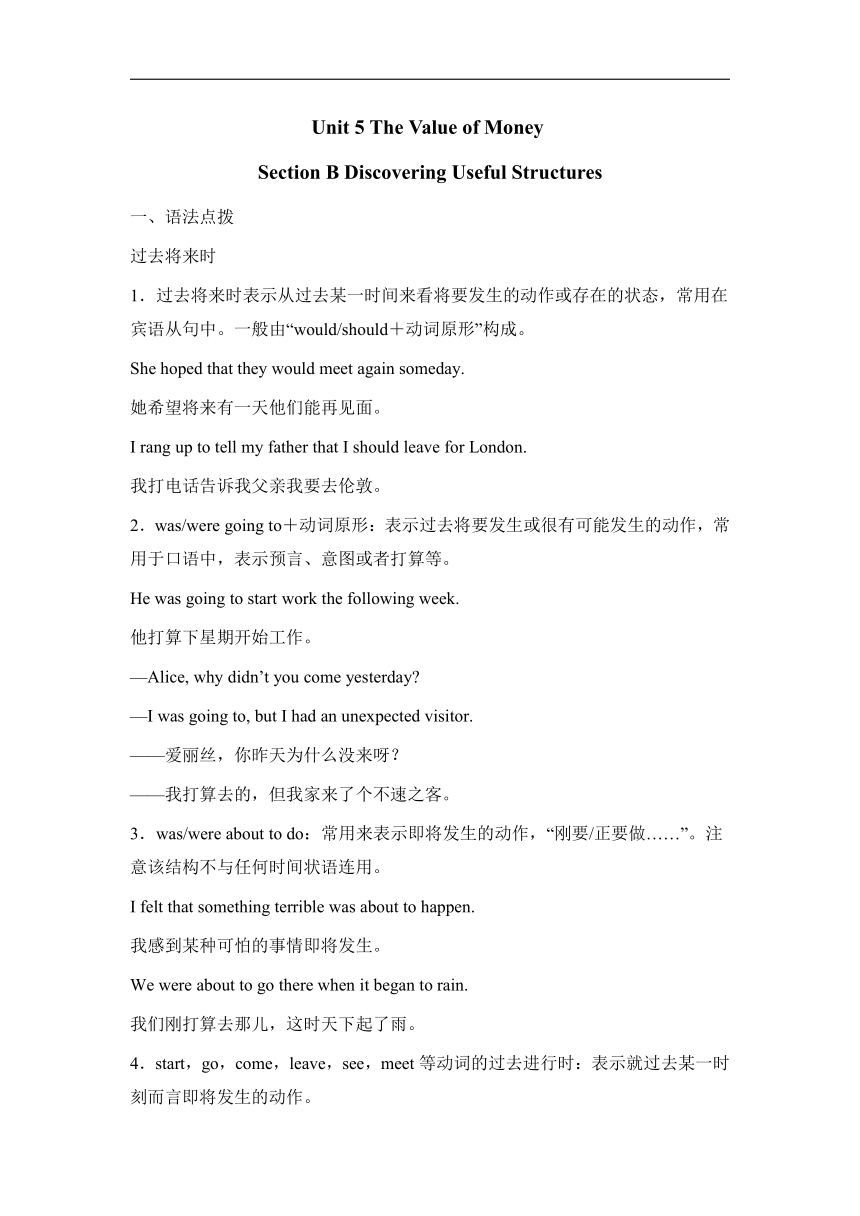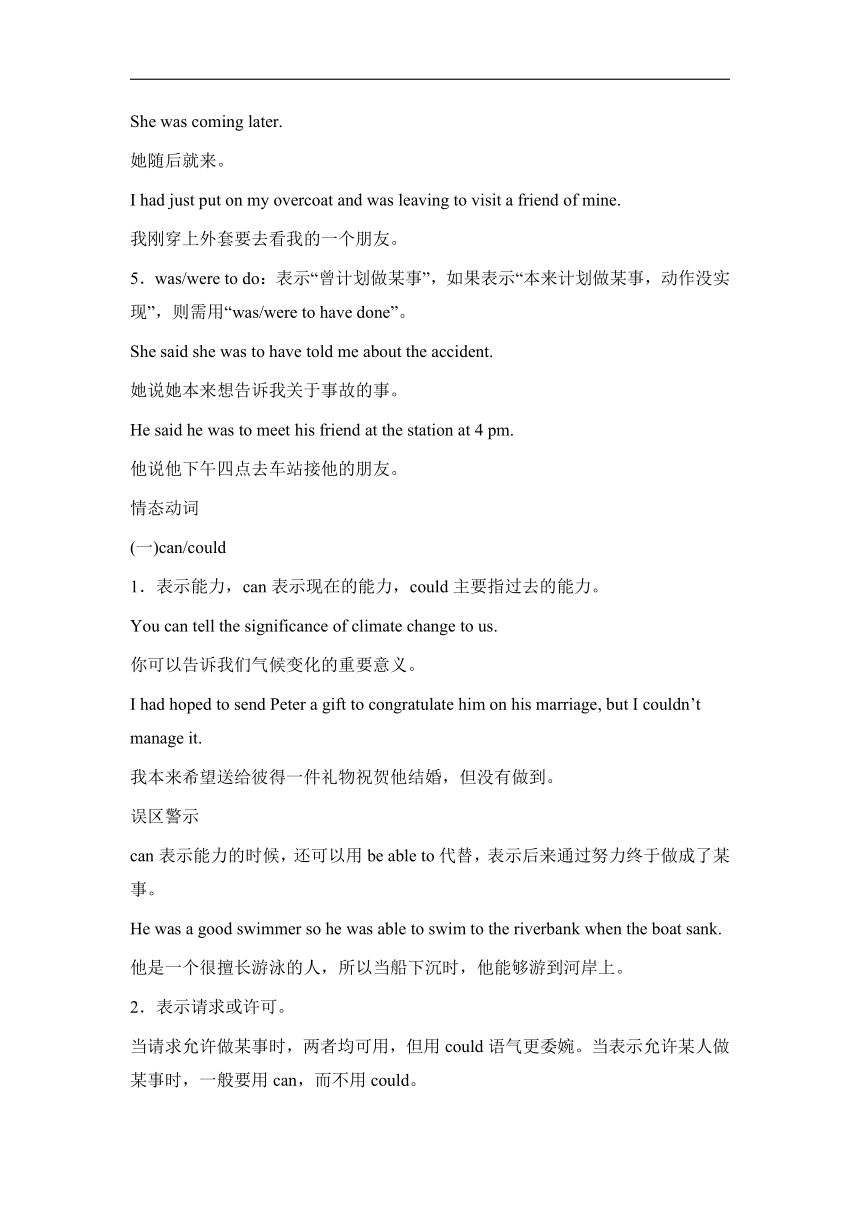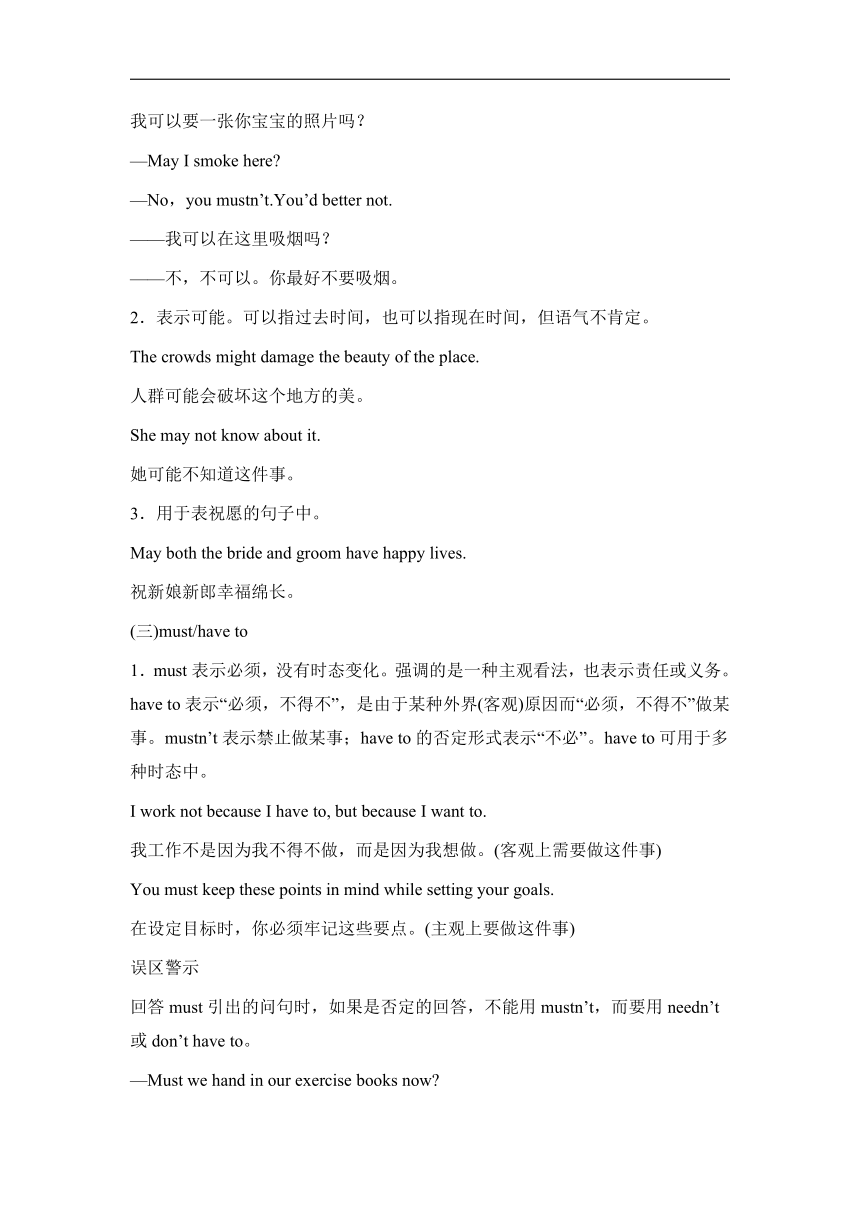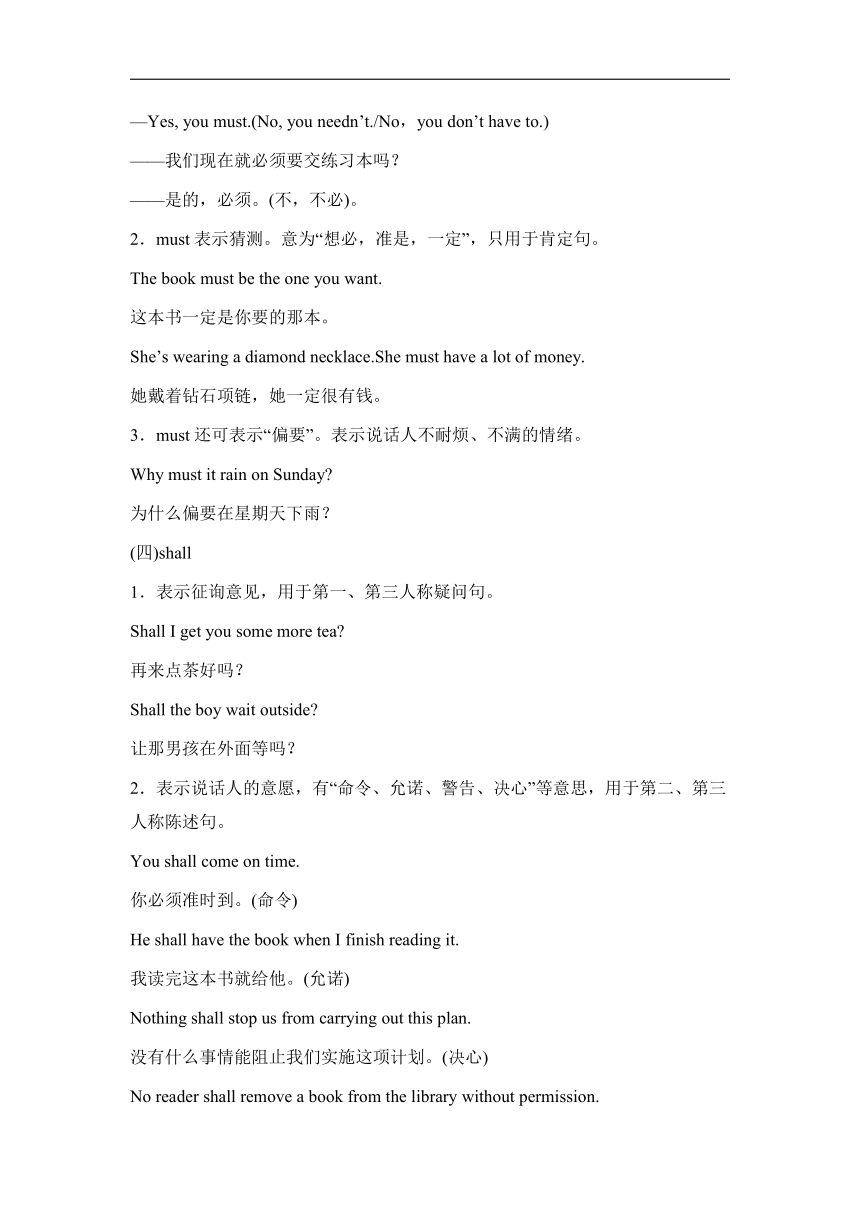人教版(2019)必修第三册:Unit 5 The Value of Money Discovering Useful Structures 学案(含答案)
文档属性
| 名称 | 人教版(2019)必修第三册:Unit 5 The Value of Money Discovering Useful Structures 学案(含答案) |  | |
| 格式 | docx | ||
| 文件大小 | 38.3KB | ||
| 资源类型 | 教案 | ||
| 版本资源 | 人教版(2019) | ||
| 科目 | 英语 | ||
| 更新时间 | 2022-12-28 20:43:37 | ||
图片预览





文档简介
Unit 5 The Value of Money
Section B Discovering Useful Structures
一、语法点拨
过去将来时
1.过去将来时表示从过去某一时间来看将要发生的动作或存在的状态,常用在宾语从句中。一般由“would/should+动词原形”构成。
She hoped that they would meet again someday.
她希望将来有一天他们能再见面。
I rang up to tell my father that I should leave for London.
我打电话告诉我父亲我要去伦敦。
2.was/were going to+动词原形:表示过去将要发生或很有可能发生的动作,常用于口语中,表示预言、意图或者打算等。
He was going to start work the following week.
他打算下星期开始工作。
—Alice, why didn’t you come yesterday
—I was going to, but I had an unexpected visitor.
——爱丽丝,你昨天为什么没来呀?
——我打算去的,但我家来了个不速之客。
3.was/were about to do:常用来表示即将发生的动作,“刚要/正要做……”。注意该结构不与任何时间状语连用。
I felt that something terrible was about to happen.
我感到某种可怕的事情即将发生。
We were about to go there when it began to rain.
我们刚打算去那儿,这时天下起了雨。
4.start,go,come,leave,see,meet等动词的过去进行时:表示就过去某一时刻而言即将发生的动作。
She was coming later.
她随后就来。
I had just put on my overcoat and was leaving to visit a friend of mine.
我刚穿上外套要去看我的一个朋友。
5.was/were to do:表示“曾计划做某事”,如果表示“本来计划做某事,动作没实现”,则需用“was/were to have done”。
She said she was to have told me about the accident.
她说她本来想告诉我关于事故的事。
He said he was to meet his friend at the station at 4 pm.
他说他下午四点去车站接他的朋友。
情态动词
(一)can/could
1.表示能力,can表示现在的能力,could主要指过去的能力。
You can tell the significance of climate change to us.
你可以告诉我们气候变化的重要意义。
I had hoped to send Peter a gift to congratulate him on his marriage, but I couldn’t manage it.
我本来希望送给彼得一件礼物祝贺他结婚,但没有做到。
误区警示
can表示能力的时候,还可以用be able to代替,表示后来通过努力终于做成了某事。
He was a good swimmer so he was able to swim to the riverbank when the boat sank.
他是一个很擅长游泳的人,所以当船下沉时,他能够游到河岸上。
2.表示请求或许可。
当请求允许做某事时,两者均可用,但用could语气更委婉。当表示允许某人做某事时,一般要用can,而不用could。
—Can/Could I use your bike tomorrow morning
—Yes, you can./No,I’m afraid not.
——我明天早晨能用你的自行车吗?
——是的,可以。/不,恐怕不行。
You can go with them if you like.
如果你愿意的话,可以和他们一起去。
3.表示推测。
can表推测时一般用于否定句和疑问句中(could一般无此限制)。表示对过去发生的行为怀疑或不肯定时,常用“can/could+have+过去分词”的否定或疑问形式。
It can’t/couldn’t be true.
那不可能是真的。
Can/Could he have heard the news
他听说过这个消息了吗?
4.表示客观的、一时的情况,意思是“有时候会”。
The weather in Shanghai can/could be very cold in winter.
上海冬季可能很冷。
5.表示惊异、怀疑,不相信的态度(主要用在否定句、疑问句或感叹句中)。
How can you be so careless!
你怎么那么粗心呀!
(二)may/might
1.表示请求或允许,might可以指过去时间,也可指现在时间,语气更委婉。对may的一般疑问句的肯定回答可用may或can,但作否定回答时要用mustn’t或can’t。
You may come if you wish.
如果你想来,你就来。
May(Might) I ask for a photo of your baby
我可以要一张你宝宝的照片吗?
—May I smoke here
—No,you mustn’t.You’d better not.
——我可以在这里吸烟吗?
——不,不可以。你最好不要吸烟。
2.表示可能。可以指过去时间,也可以指现在时间,但语气不肯定。
The crowds might damage the beauty of the place.
人群可能会破坏这个地方的美。
She may not know about it.
她可能不知道这件事。
3.用于表祝愿的句子中。
May both the bride and groom have happy lives.
祝新娘新郎幸福绵长。
(三)must/have to
1.must表示必须,没有时态变化。强调的是一种主观看法,也表示责任或义务。have to表示“必须,不得不”,是由于某种外界(客观)原因而“必须,不得不”做某事。mustn’t表示禁止做某事;have to的否定形式表示“不必”。have to可用于多种时态中。
I work not because I have to, but because I want to.
我工作不是因为我不得不做,而是因为我想做。(客观上需要做这件事)
You must keep these points in mind while setting your goals.
在设定目标时,你必须牢记这些要点。(主观上要做这件事)
误区警示
回答must引出的问句时,如果是否定的回答,不能用mustn’t,而要用needn’t或don’t have to。
—Must we hand in our exercise books now
—Yes, you must.(No, you needn’t./No,you don’t have to.)
——我们现在就必须要交练习本吗?
——是的,必须。(不,不必)。
2.must表示猜测。意为“想必,准是,一定”,只用于肯定句。
The book must be the one you want.
这本书一定是你要的那本。
She’s wearing a diamond necklace.She must have a lot of money.
她戴着钻石项链,她一定很有钱。
3.must还可表示“偏要”。表示说话人不耐烦、不满的情绪。
Why must it rain on Sunday
为什么偏要在星期天下雨?
(四)shall
1.表示征询意见,用于第一、第三人称疑问句。
Shall I get you some more tea
再来点茶好吗?
Shall the boy wait outside
让那男孩在外面等吗?
2.表示说话人的意愿,有“命令、允诺、警告、决心”等意思,用于第二、第三人称陈述句。
You shall come on time.
你必须准时到。(命令)
He shall have the book when I finish reading it.
我读完这本书就给他。(允诺)
Nothing shall stop us from carrying out this plan.
没有什么事情能阻止我们实施这项计划。(决心)
No reader shall remove a book from the library without permission.
未经许可,读者不准把书带出图书馆。(警告)
3.表示强制,用于法令、条约、规章中,意为“必须;应该”。
One of our rules is that every student shall wear school uniform while at school.
我们规定中的其中一项是:每位学生在校期间都要穿校服。
Each part shall respect the articles of this contract.
任何一方都要尊重合同的条款。
(五)should
1.表示义务、责任,意为“应该”,用于各种人称。
(2019·北京高考)Students should have a proper attitude towards college before thinking about which college to attend.
在考虑上哪所大学之前,学生应该对大学有一个正确的态度。
You should be polite to your teachers.
你对老师应该有礼貌。
2.表示可能性很大的猜测,说明说话人对客观事物的真实性作出较大可能的判断,意为“想必一定,照说应该;估计”等。
The film should be very good as it is starring first-class actors.
这部电影是一流演员主演的,估计拍得很好。
3.表示说话人的惊讶、愤怒、失望等特殊情感,意为“居然,竟然”。
Amazing! You should wear slippers at work.
真令人惊讶,你竟然穿着拖鞋上班!
(六)will/would
1.表示意志或意愿。will指现在,would指过去,用于否定句表示“不肯,不乐意”。
I will never do that again.
我决不会再做那种事了。
2.表示征求意见或提出请求。主要用于第二人称疑问句中,will和would均可用,would此时不表示过去,而是表示委婉语气。
Will/Would you pass me the book
请你把书递给我好吗?
3.will和would可分别表示现在和过去反复发生的动作或某种倾向,意为“总是;常常”。
Fish will die without water.
没有水,鱼会死去。
When my parents were away, my grandmother would take care of me.
我父母外出的时候,总是祖母照看我。
(七)need
1.用作情态动词,need意为“需要,有必要”,一般用于否定句或疑问句中。疑问句中把need提前,否定形式是在need后加not。
You needn’t come here this afternoon.
你今天下午不必来。
2.用作实义动词,意为“需要,有必要”,可以用于各种句式中。
You don’t need to go now.
你不必现在就走。
I need to have a rest.
我需要休息一下。
Do we need to finish all the work today
我们今天需要完成所有的工作吗?
(八)dare
1.dare作情态动词时,常用于疑问句、否定句和条件从句中,过去形式为dared。
How dare you say I’m unfair
你怎么敢说我不公平?
He daren’t speak English before such a crowd, dare he
他不敢在这么多人面前说英语,是吗?
If we dared not go there that day, we couldn’t get the beautiful flowers.
如果那天我们不敢去那里,我们就得不到美丽的花。
2.dare作实义动词用时,有人称、时态和数的变化。在肯定句中,dare后面常接带to的不定式。在疑问句和否定句中,dare后面可接带to或不带to的不定式。
I dare to swim across this river.
我敢游过这条河。
He doesn’t dare (to) answer.
他不敢回答。
二、同步练习
1.他告诉我他可能会迟到。
He told me he _______ be late.
2.他一定是生病了。他看起来气色很不好。
He _______ be ill. He looks so pale.
3.当我在看电视的时候,你为什么偏要打搅我呢?
Why ________ you interrupt me while I am watching TV
4.那不可能是我们的校长。他去美国了。
It _______ _______ be our headmaster. He has gone to America.
5.我本应该昨天上交我的作业的,但不幸的是,我完全忘记这回事了。
I _______ _______ handed in my homework yesterday, but unfortunately I forgot about it totally.
6.如果我完成了作业,我可能会去徒步旅行。
I ________ go hiking if I finish my homework.
7.如果时间允许,他能够参加足球比赛。
He ________ compete in the football match if time permits.
8.你应该比你其他的同班同学更加努力学习。
You _______ /_______ _______ study harder than your other classmates.
9.昨天,他不能相信他的眼睛。
Yesterday, he ________ ________ believe his eyes.
10.他最好做一些研究。
He _______ _______ do some research.
11. The Forbidden City in Beijing, home to the Palace Museum, houses more than 1.8 million cultural relics and is one of the world's most visited tourist ①________ ( attract).
②________ ( mark) the 600th anniversary of the Forbidden City, the Palace Museum will hold a series of events throughout 2020. Over 20 exhibitions will be held, ③________ (cover) different areas such as history, art, festivals, and so on. For the special occasion, Along the Bian River during the Qingming Festival, one of China's most ④________ ( wide ) known masterpieces, will go ⑤________ display in September 2020. For ⑥(________ it) best preservation, this treasured artwork is seldom fully exhibited. The painting ⑦________ (display) for the first time back in 2005 to celebrate the museum's 80th anniversary. Such ⑧________ rare sight is expected to draw huge crowds. In addition, the museum will also display exhibits from other ⑨________ ( country).
During the past few years, the Palace Museum has been working hard to get the public familiar with the history and culture of the Forbidden City. And it seems that these efforts have been paying off, with its popularity reaching a new height. Over 17 million people visited the museum in 2018, of ⑩________ 40 percent were under 30 years old.
答案以及解析
1.答案:might
2.答案:must
3.答案:must
4.答案:can not
5.答案:should have
6.答案:might
7.答案:can
8.答案:should/ought to
9.答案:could not
10.答案:had better
11.答案:①-⑤ attractions; To mark; covering; widely; on ⑥-⑩ its; was displayed; a; countries; whom
解析:①考查名词的数。句意:北京故宫博物院所在地,拥有180多万件文物,是世界上游客最多的旅游景点之一。one of后跟名词的复数形式,表示“…其中之一”,故填attractions。
②考查非谓语动词。句意:为了纪念故宫建成600周年,故宫博物院将在2020年举办一系列活动。此处用不定式表目的,故填 To mark。
③考查非谓语动词。句意将举办20多个展览,涵盖历史、艺术、节日等不同领域。 cover与其逻辑主语Over 20 exhibitions之间构成主动关系,故填现在分词 covering 。
④考查副词。此处指中国最广为人知的杰作之一。known为形容词,需要用副词修饰,故填 widely。
⑤考查介词。短语 on display意为“展出”,故填on。
⑥考查形容词性物主代词。 preservation为名词,需要用形容词性物主代词修饰,故填its。
⑦考查动词的时态和语态。句意:这幅画于2005年首次展出,以庆祝该博物馆成立80周年。根据时间状语in 2005可知用一般过去时,且主语 The painting与谓语动词构成被动关系,故填 was displayed。
⑧考查冠词。句意:如此罕见的景象预计将吸引大批群众。 sight为名词,此处表泛指,故填不定冠词a。
⑨考查名词的数。句意:此外,博物馆还将展出其他国家的展品。 country为可数名词,由 other修饰数量大于一, 故填复数形式 countries。
⑩考查定语从句。句意:2018年,超过1700万人参观了故宫博物院,其中40%的人不到30岁。of ⑩_____引导定语从句,修饰先行词 people,关系词在从句中作介词of的宾语,故填whom。
Section B Discovering Useful Structures
一、语法点拨
过去将来时
1.过去将来时表示从过去某一时间来看将要发生的动作或存在的状态,常用在宾语从句中。一般由“would/should+动词原形”构成。
She hoped that they would meet again someday.
她希望将来有一天他们能再见面。
I rang up to tell my father that I should leave for London.
我打电话告诉我父亲我要去伦敦。
2.was/were going to+动词原形:表示过去将要发生或很有可能发生的动作,常用于口语中,表示预言、意图或者打算等。
He was going to start work the following week.
他打算下星期开始工作。
—Alice, why didn’t you come yesterday
—I was going to, but I had an unexpected visitor.
——爱丽丝,你昨天为什么没来呀?
——我打算去的,但我家来了个不速之客。
3.was/were about to do:常用来表示即将发生的动作,“刚要/正要做……”。注意该结构不与任何时间状语连用。
I felt that something terrible was about to happen.
我感到某种可怕的事情即将发生。
We were about to go there when it began to rain.
我们刚打算去那儿,这时天下起了雨。
4.start,go,come,leave,see,meet等动词的过去进行时:表示就过去某一时刻而言即将发生的动作。
She was coming later.
她随后就来。
I had just put on my overcoat and was leaving to visit a friend of mine.
我刚穿上外套要去看我的一个朋友。
5.was/were to do:表示“曾计划做某事”,如果表示“本来计划做某事,动作没实现”,则需用“was/were to have done”。
She said she was to have told me about the accident.
她说她本来想告诉我关于事故的事。
He said he was to meet his friend at the station at 4 pm.
他说他下午四点去车站接他的朋友。
情态动词
(一)can/could
1.表示能力,can表示现在的能力,could主要指过去的能力。
You can tell the significance of climate change to us.
你可以告诉我们气候变化的重要意义。
I had hoped to send Peter a gift to congratulate him on his marriage, but I couldn’t manage it.
我本来希望送给彼得一件礼物祝贺他结婚,但没有做到。
误区警示
can表示能力的时候,还可以用be able to代替,表示后来通过努力终于做成了某事。
He was a good swimmer so he was able to swim to the riverbank when the boat sank.
他是一个很擅长游泳的人,所以当船下沉时,他能够游到河岸上。
2.表示请求或许可。
当请求允许做某事时,两者均可用,但用could语气更委婉。当表示允许某人做某事时,一般要用can,而不用could。
—Can/Could I use your bike tomorrow morning
—Yes, you can./No,I’m afraid not.
——我明天早晨能用你的自行车吗?
——是的,可以。/不,恐怕不行。
You can go with them if you like.
如果你愿意的话,可以和他们一起去。
3.表示推测。
can表推测时一般用于否定句和疑问句中(could一般无此限制)。表示对过去发生的行为怀疑或不肯定时,常用“can/could+have+过去分词”的否定或疑问形式。
It can’t/couldn’t be true.
那不可能是真的。
Can/Could he have heard the news
他听说过这个消息了吗?
4.表示客观的、一时的情况,意思是“有时候会”。
The weather in Shanghai can/could be very cold in winter.
上海冬季可能很冷。
5.表示惊异、怀疑,不相信的态度(主要用在否定句、疑问句或感叹句中)。
How can you be so careless!
你怎么那么粗心呀!
(二)may/might
1.表示请求或允许,might可以指过去时间,也可指现在时间,语气更委婉。对may的一般疑问句的肯定回答可用may或can,但作否定回答时要用mustn’t或can’t。
You may come if you wish.
如果你想来,你就来。
May(Might) I ask for a photo of your baby
我可以要一张你宝宝的照片吗?
—May I smoke here
—No,you mustn’t.You’d better not.
——我可以在这里吸烟吗?
——不,不可以。你最好不要吸烟。
2.表示可能。可以指过去时间,也可以指现在时间,但语气不肯定。
The crowds might damage the beauty of the place.
人群可能会破坏这个地方的美。
She may not know about it.
她可能不知道这件事。
3.用于表祝愿的句子中。
May both the bride and groom have happy lives.
祝新娘新郎幸福绵长。
(三)must/have to
1.must表示必须,没有时态变化。强调的是一种主观看法,也表示责任或义务。have to表示“必须,不得不”,是由于某种外界(客观)原因而“必须,不得不”做某事。mustn’t表示禁止做某事;have to的否定形式表示“不必”。have to可用于多种时态中。
I work not because I have to, but because I want to.
我工作不是因为我不得不做,而是因为我想做。(客观上需要做这件事)
You must keep these points in mind while setting your goals.
在设定目标时,你必须牢记这些要点。(主观上要做这件事)
误区警示
回答must引出的问句时,如果是否定的回答,不能用mustn’t,而要用needn’t或don’t have to。
—Must we hand in our exercise books now
—Yes, you must.(No, you needn’t./No,you don’t have to.)
——我们现在就必须要交练习本吗?
——是的,必须。(不,不必)。
2.must表示猜测。意为“想必,准是,一定”,只用于肯定句。
The book must be the one you want.
这本书一定是你要的那本。
She’s wearing a diamond necklace.She must have a lot of money.
她戴着钻石项链,她一定很有钱。
3.must还可表示“偏要”。表示说话人不耐烦、不满的情绪。
Why must it rain on Sunday
为什么偏要在星期天下雨?
(四)shall
1.表示征询意见,用于第一、第三人称疑问句。
Shall I get you some more tea
再来点茶好吗?
Shall the boy wait outside
让那男孩在外面等吗?
2.表示说话人的意愿,有“命令、允诺、警告、决心”等意思,用于第二、第三人称陈述句。
You shall come on time.
你必须准时到。(命令)
He shall have the book when I finish reading it.
我读完这本书就给他。(允诺)
Nothing shall stop us from carrying out this plan.
没有什么事情能阻止我们实施这项计划。(决心)
No reader shall remove a book from the library without permission.
未经许可,读者不准把书带出图书馆。(警告)
3.表示强制,用于法令、条约、规章中,意为“必须;应该”。
One of our rules is that every student shall wear school uniform while at school.
我们规定中的其中一项是:每位学生在校期间都要穿校服。
Each part shall respect the articles of this contract.
任何一方都要尊重合同的条款。
(五)should
1.表示义务、责任,意为“应该”,用于各种人称。
(2019·北京高考)Students should have a proper attitude towards college before thinking about which college to attend.
在考虑上哪所大学之前,学生应该对大学有一个正确的态度。
You should be polite to your teachers.
你对老师应该有礼貌。
2.表示可能性很大的猜测,说明说话人对客观事物的真实性作出较大可能的判断,意为“想必一定,照说应该;估计”等。
The film should be very good as it is starring first-class actors.
这部电影是一流演员主演的,估计拍得很好。
3.表示说话人的惊讶、愤怒、失望等特殊情感,意为“居然,竟然”。
Amazing! You should wear slippers at work.
真令人惊讶,你竟然穿着拖鞋上班!
(六)will/would
1.表示意志或意愿。will指现在,would指过去,用于否定句表示“不肯,不乐意”。
I will never do that again.
我决不会再做那种事了。
2.表示征求意见或提出请求。主要用于第二人称疑问句中,will和would均可用,would此时不表示过去,而是表示委婉语气。
Will/Would you pass me the book
请你把书递给我好吗?
3.will和would可分别表示现在和过去反复发生的动作或某种倾向,意为“总是;常常”。
Fish will die without water.
没有水,鱼会死去。
When my parents were away, my grandmother would take care of me.
我父母外出的时候,总是祖母照看我。
(七)need
1.用作情态动词,need意为“需要,有必要”,一般用于否定句或疑问句中。疑问句中把need提前,否定形式是在need后加not。
You needn’t come here this afternoon.
你今天下午不必来。
2.用作实义动词,意为“需要,有必要”,可以用于各种句式中。
You don’t need to go now.
你不必现在就走。
I need to have a rest.
我需要休息一下。
Do we need to finish all the work today
我们今天需要完成所有的工作吗?
(八)dare
1.dare作情态动词时,常用于疑问句、否定句和条件从句中,过去形式为dared。
How dare you say I’m unfair
你怎么敢说我不公平?
He daren’t speak English before such a crowd, dare he
他不敢在这么多人面前说英语,是吗?
If we dared not go there that day, we couldn’t get the beautiful flowers.
如果那天我们不敢去那里,我们就得不到美丽的花。
2.dare作实义动词用时,有人称、时态和数的变化。在肯定句中,dare后面常接带to的不定式。在疑问句和否定句中,dare后面可接带to或不带to的不定式。
I dare to swim across this river.
我敢游过这条河。
He doesn’t dare (to) answer.
他不敢回答。
二、同步练习
1.他告诉我他可能会迟到。
He told me he _______ be late.
2.他一定是生病了。他看起来气色很不好。
He _______ be ill. He looks so pale.
3.当我在看电视的时候,你为什么偏要打搅我呢?
Why ________ you interrupt me while I am watching TV
4.那不可能是我们的校长。他去美国了。
It _______ _______ be our headmaster. He has gone to America.
5.我本应该昨天上交我的作业的,但不幸的是,我完全忘记这回事了。
I _______ _______ handed in my homework yesterday, but unfortunately I forgot about it totally.
6.如果我完成了作业,我可能会去徒步旅行。
I ________ go hiking if I finish my homework.
7.如果时间允许,他能够参加足球比赛。
He ________ compete in the football match if time permits.
8.你应该比你其他的同班同学更加努力学习。
You _______ /_______ _______ study harder than your other classmates.
9.昨天,他不能相信他的眼睛。
Yesterday, he ________ ________ believe his eyes.
10.他最好做一些研究。
He _______ _______ do some research.
11. The Forbidden City in Beijing, home to the Palace Museum, houses more than 1.8 million cultural relics and is one of the world's most visited tourist ①________ ( attract).
②________ ( mark) the 600th anniversary of the Forbidden City, the Palace Museum will hold a series of events throughout 2020. Over 20 exhibitions will be held, ③________ (cover) different areas such as history, art, festivals, and so on. For the special occasion, Along the Bian River during the Qingming Festival, one of China's most ④________ ( wide ) known masterpieces, will go ⑤________ display in September 2020. For ⑥(________ it) best preservation, this treasured artwork is seldom fully exhibited. The painting ⑦________ (display) for the first time back in 2005 to celebrate the museum's 80th anniversary. Such ⑧________ rare sight is expected to draw huge crowds. In addition, the museum will also display exhibits from other ⑨________ ( country).
During the past few years, the Palace Museum has been working hard to get the public familiar with the history and culture of the Forbidden City. And it seems that these efforts have been paying off, with its popularity reaching a new height. Over 17 million people visited the museum in 2018, of ⑩________ 40 percent were under 30 years old.
答案以及解析
1.答案:might
2.答案:must
3.答案:must
4.答案:can not
5.答案:should have
6.答案:might
7.答案:can
8.答案:should/ought to
9.答案:could not
10.答案:had better
11.答案:①-⑤ attractions; To mark; covering; widely; on ⑥-⑩ its; was displayed; a; countries; whom
解析:①考查名词的数。句意:北京故宫博物院所在地,拥有180多万件文物,是世界上游客最多的旅游景点之一。one of后跟名词的复数形式,表示“…其中之一”,故填attractions。
②考查非谓语动词。句意:为了纪念故宫建成600周年,故宫博物院将在2020年举办一系列活动。此处用不定式表目的,故填 To mark。
③考查非谓语动词。句意将举办20多个展览,涵盖历史、艺术、节日等不同领域。 cover与其逻辑主语Over 20 exhibitions之间构成主动关系,故填现在分词 covering 。
④考查副词。此处指中国最广为人知的杰作之一。known为形容词,需要用副词修饰,故填 widely。
⑤考查介词。短语 on display意为“展出”,故填on。
⑥考查形容词性物主代词。 preservation为名词,需要用形容词性物主代词修饰,故填its。
⑦考查动词的时态和语态。句意:这幅画于2005年首次展出,以庆祝该博物馆成立80周年。根据时间状语in 2005可知用一般过去时,且主语 The painting与谓语动词构成被动关系,故填 was displayed。
⑧考查冠词。句意:如此罕见的景象预计将吸引大批群众。 sight为名词,此处表泛指,故填不定冠词a。
⑨考查名词的数。句意:此外,博物馆还将展出其他国家的展品。 country为可数名词,由 other修饰数量大于一, 故填复数形式 countries。
⑩考查定语从句。句意:2018年,超过1700万人参观了故宫博物院,其中40%的人不到30岁。of ⑩_____引导定语从句,修饰先行词 people,关系词在从句中作介词of的宾语,故填whom。
